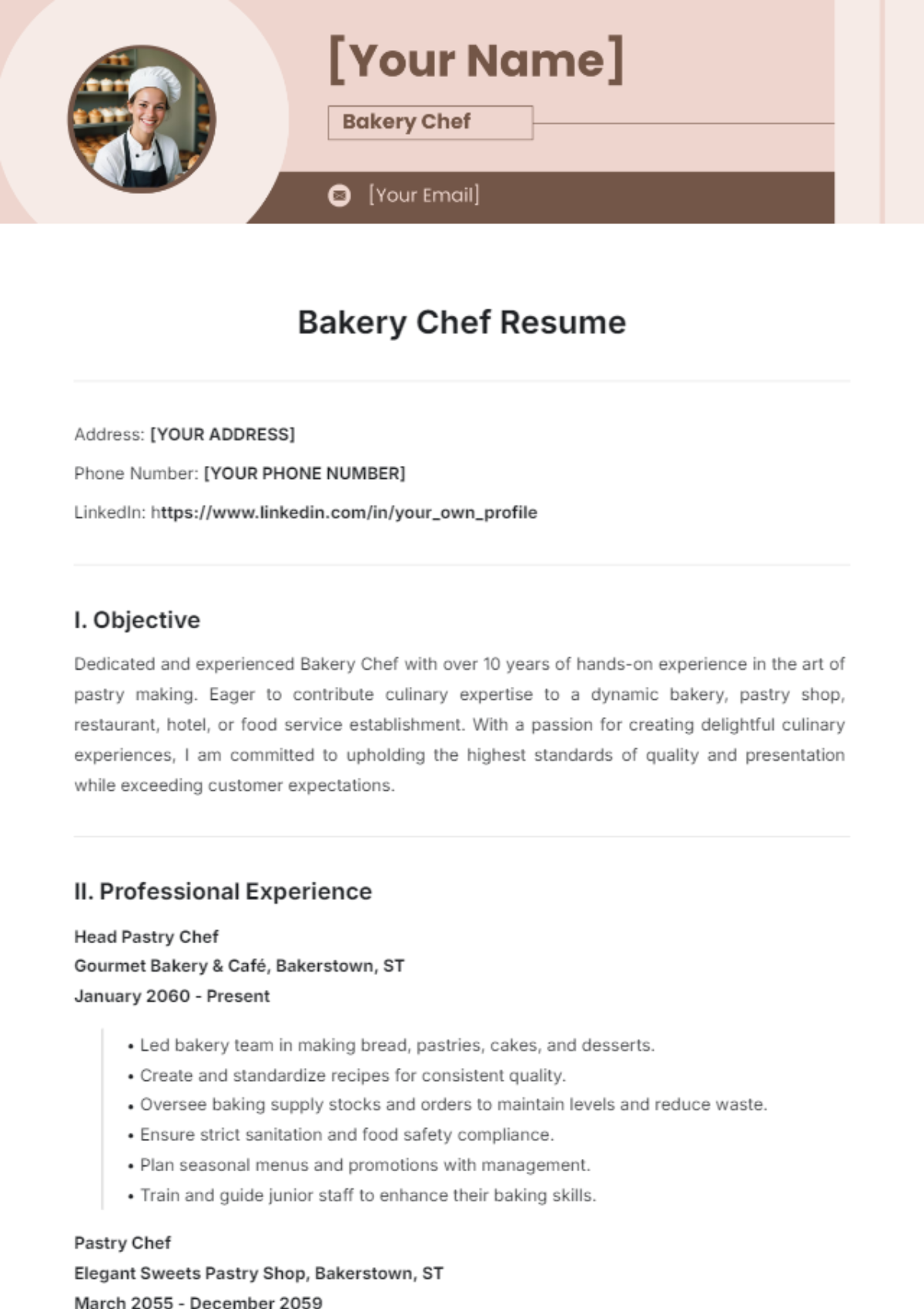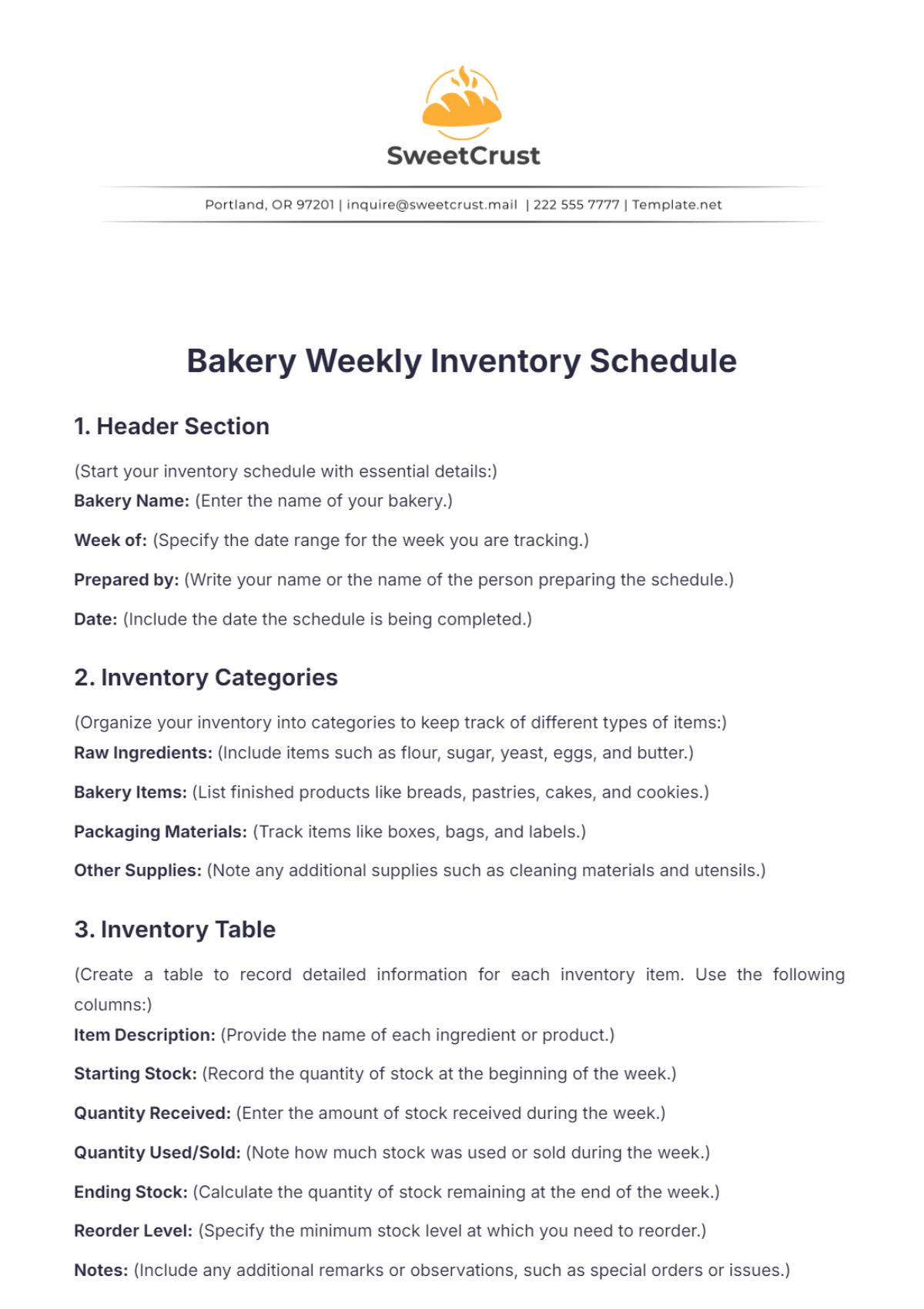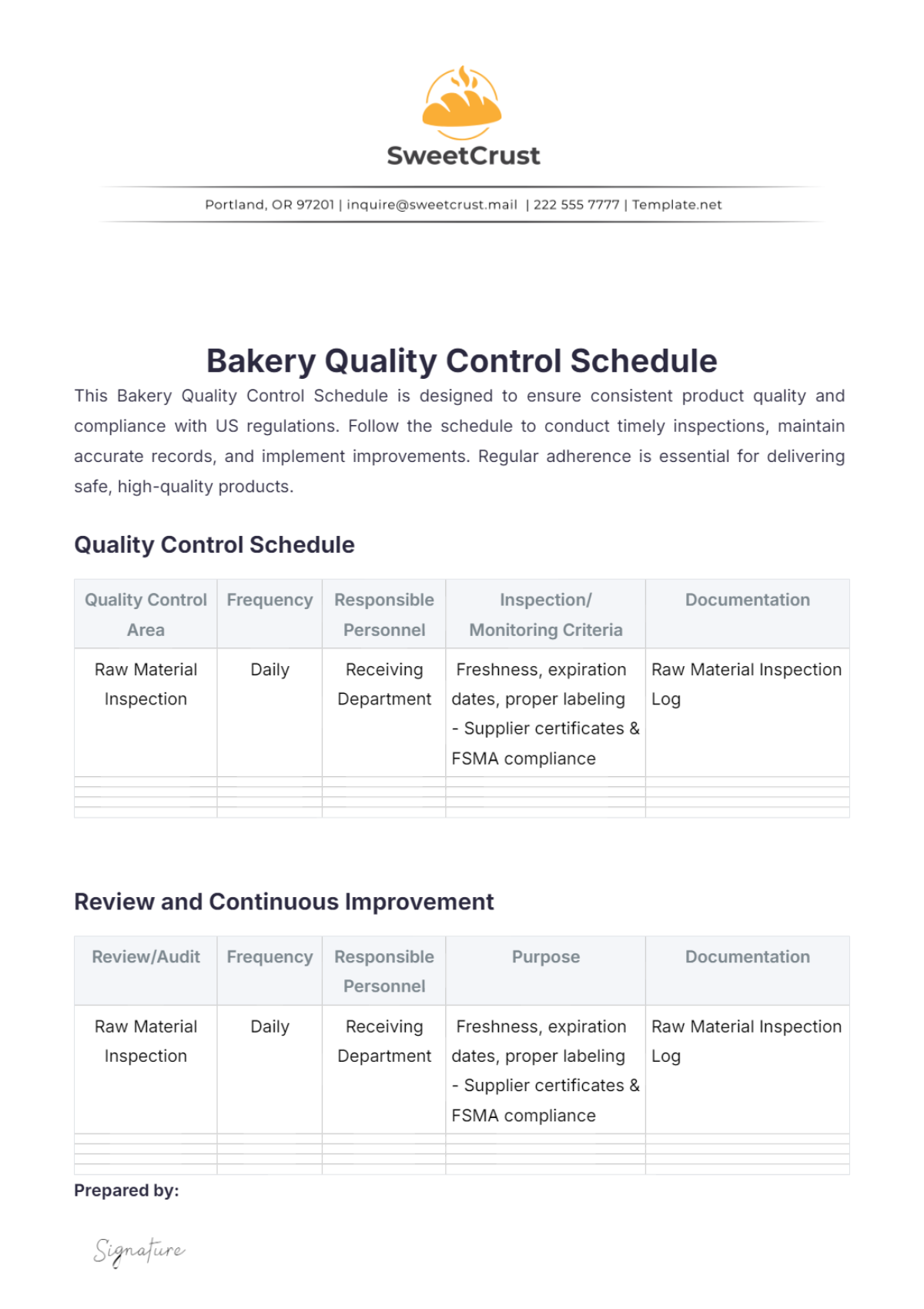Bakery Safety Guideline Outline
I. Introduction
(Begin this section by introducing the purpose of the safety guideline document. Explain why safety is critical in a bakery environment. Provide a brief overview of what the guideline will cover. Highlight the commitment of [Your Company Name] to ensuring a safe working environment for all employees.)
II. Personal Protective Equipment (PPE)
(Describe the importance of PPE in the bakery. List the types of PPE required for different tasks. Explain how and when to use each type of PPE. Include instructions for proper maintenance and storage of PPE.)
A. Types of PPE
(PPE is essential to protect employees from potential hazards. Specify the types of PPE needed, such as gloves, aprons, hairnets, and safety shoes.)
Gloves (Explain the importance of wearing gloves to protect hands from burns, cuts, and contamination. Detail when and where gloves should be worn, and the types of gloves suitable for different tasks.)
Aprons (Describe the use of aprons to protect clothing and skin from spills and burns. Specify the materials suitable for aprons in a bakery setting.)
Hairnets and Beard Nets (Emphasize the importance of wearing hairnets and beard nets to prevent hair from contaminating food products. Provide guidelines on proper usage.)
Safety Shoes (Discuss the need for safety shoes to protect feet from falling objects and slippery surfaces. Describe the features of appropriate safety footwear.)
B. Usage and Maintenance
(Provide detailed instructions on how to properly use and maintain PPE. Include information on regular inspection, cleaning procedures, and replacement schedules.)
Proper Usage (Explain step-by-step how to correctly wear each type of PPE. Include diagrams or images if necessary to illustrate proper usage.)
Maintenance and Storage (Detail the procedures for cleaning and storing PPE. Highlight the importance of regular inspection for wear and tear and provide guidelines for replacing damaged PPE.)
III. Machinery Safety
(Explain the significance of machinery safety in the bakery. Identify common machines used and the associated risks. Provide guidelines for safe operation, maintenance, and emergency procedures.)
A. Common Bakery Machines
(List the common machines found in a bakery, such as mixers, ovens, and slicers. Describe the function and potential hazards of each machine.)
Mixers (Discuss the hazards associated with mixers, such as moving parts and electrical risks. Provide safety tips for operating mixers, including proper startup and shutdown procedures.)
Ovens (Describe the risks involved in using ovens, including burns and fire hazards. Offer guidelines for safe operation, including preheating procedures, temperature monitoring, and proper use of oven mitts.)
Slicers (Explain the dangers of using slicers, such as cuts and amputations. Provide instructions on safe operation, including proper blade handling and safety guards.)
B. Safe Operation
(Provide detailed guidelines for the safe operation of bakery machinery. Emphasize the importance of following manufacturer instructions and safety protocols.)
Training (Highlight the necessity of proper training for all employees who operate machinery. Specify the topics covered in training sessions, such as machine operation, safety features, and emergency shutdown procedures.)
Safety Checks (Detail the regular safety checks that should be performed before using any machinery. Include a checklist of items to inspect, such as power cords, safety guards, and emergency stop buttons.)
C. Maintenance and Emergency Procedures
(Discuss the importance of regular maintenance to ensure machinery is in good working condition. Provide guidelines for handling machinery emergencies.)
Regular Maintenance (Explain the procedures for routine maintenance, including lubrication, cleaning, and part replacement. Specify the frequency of maintenance tasks and the personnel responsible.)
Emergency Procedures (Provide step-by-step instructions for handling machinery emergencies, such as equipment malfunctions and injuries. Include information on emergency shutdown procedures and first aid measures.)
IV. Fire Safety
(Discuss the potential fire hazards in a bakery and the importance of fire safety. Provide guidelines for fire prevention, emergency response, and the use of fire extinguishers.)
A. Fire Hazards in the Bakery
(Identify common fire hazards in the bakery, such as flammable materials, electrical equipment, and open flames. Describe the risks associated with each hazard.)
Flammable Materials (Explain the dangers of flammable materials, such as oils, flour dust, and packaging materials. Provide guidelines for proper storage and handling to minimize fire risks.)
Electrical Equipment (Discuss the fire risks associated with electrical equipment, such as mixers and ovens. Provide safety tips for using and maintaining electrical equipment to prevent fires.)
Open Flames (Describe the hazards of open flames, such as those from gas stoves and ovens. Offer guidelines for safe use and monitoring of open flames.)
B. Fire Prevention
(Provide detailed guidelines for preventing fires in the bakery. Include information on safe practices, equipment maintenance, and regular inspections.)
Safe Practices (Explain the importance of safe practices, such as keeping flammable materials away from heat sources and not overloading electrical outlets. Provide a list of best practices for fire prevention.)
Equipment Maintenance (Discuss the role of regular equipment maintenance in preventing fires. Specify maintenance tasks that reduce fire risks, such as cleaning grease traps and checking electrical connections.)
Inspections (Highlight the importance of regular fire safety inspections. Provide a checklist for inspecting fire hazards, such as checking fire extinguisher pressure and ensuring clear evacuation routes.)
C. Emergency Response
(Provide step-by-step instructions for responding to a fire emergency. Include guidelines for using fire extinguishers, activating fire alarms, and evacuating the building.)
Using Fire Extinguishers (Explain the different types of fire extinguishers and their appropriate uses. Provide instructions on how to operate a fire extinguisher using the PASS method: Pull, Aim, Squeeze, Sweep.)
Activating Fire Alarms (Detail the procedure for activating fire alarms in the event of a fire. Include information on the location of fire alarms and how to use them.)
Evacuation Procedures (Provide clear instructions for evacuating the bakery during a fire emergency. Include information on evacuation routes, assembly points, and assisting individuals with disabilities.)
V. Hygiene and Sanitation
(Discuss the importance of hygiene and sanitation in the bakery to prevent contamination and ensure food safety. Provide guidelines for personal hygiene, cleaning procedures, and waste management.)
A. Personal Hygiene
(Emphasize the importance of personal hygiene for all bakery employees. Provide guidelines for handwashing, personal grooming, and illness reporting.)
Handwashing (Explain the critical role of handwashing in preventing contamination. Provide step-by-step instructions for proper handwashing, including frequency and techniques.)
Personal Grooming (Discuss the importance of personal grooming, such as keeping nails trimmed and wearing clean uniforms. Provide guidelines for maintaining personal cleanliness.)
Illness Reporting (Explain the importance of reporting illnesses to prevent contamination. Provide instructions for reporting symptoms and the protocol for staying home when sick.)
B. Cleaning Procedures
(Provide detailed guidelines for cleaning and sanitizing the bakery. Include information on cleaning schedules, methods, and approved cleaning products.)
Cleaning Schedules (Detail the frequency of cleaning tasks, such as daily, weekly, and monthly cleaning. Provide a sample cleaning schedule for different areas of the bakery.)
Cleaning Methods (Explain the methods for cleaning different surfaces and equipment. Include instructions for cleaning floors, countertops, machinery, and storage areas.)
Approved Cleaning Products (List the approved cleaning products and their uses. Provide guidelines for safely handling and storing cleaning chemicals.)
C. Waste Management
(Discuss the importance of proper waste management in maintaining a clean and safe bakery. Provide guidelines for waste segregation, disposal, and recycling.)
Waste Segregation (Explain the importance of segregating different types of waste, such as organic, recyclable, and hazardous waste. Provide instructions for using designated waste bins.)
Disposal Procedures (Detail the procedures for disposing of different types of waste. Include information on collection schedules and handling of hazardous waste.)
Recycling (Highlight the importance of recycling in reducing waste. Provide guidelines for recycling materials such as paper, plastic, and metal.)
VI. Emergency Procedures
(Provide comprehensive guidelines for handling various emergencies in the bakery. Include procedures for medical emergencies, chemical spills, and power outages.)
A. Medical Emergencies
(Describe the procedures for responding to medical emergencies, such as injuries and sudden illnesses. Include guidelines for first aid and calling emergency services.)
First Aid (Provide instructions for administering first aid for common injuries, such as cuts, burns, and fractures. Include information on the location of first aid kits and how to use them.)
Emergency Services (Detail the procedure for calling emergency services. Include the emergency contact numbers and the information to provide when calling.)
B. Chemical Spills
(Discuss the procedures for handling chemical spills in the bakery. Include guidelines for containing the spill, cleaning up, and reporting the incident.)
Containment (Explain the steps for containing a chemical spill to prevent it from spreading. Include information on using containment materials, such as absorbent pads and barriers.)
Cleanup (Provide instructions for safely cleaning up chemical spills. Include information on protective equipment, disposal of contaminated materials, and decontamination procedures.)
Reporting (Detail the procedure for reporting chemical spills to the appropriate authorities. Include information on documentation and follow-up actions.)
C. Power Outages
(Explain the procedures for handling power outages in the bakery. Include guidelines for maintaining food safety and restoring operations.)
Immediate Actions (Provide instructions for immediate actions to take during a power outage, such as turning off equipment and securing perishable items.)
Food Safety (Discuss the importance of maintaining food safety during a power outage. Include guidelines for monitoring temperatures and using backup power sources.)
Restoring Operations (Detail the steps for restoring operations after a power outage. Include information on checking equipment and ensuring food safety before resuming production.)
VII. Training and Education
(Emphasize the importance of ongoing training and education for all bakery employees. Provide guidelines for safety training programs, regular refreshers, and continuous improvement.)
A. Safety Training Programs
(Describe the components of safety training programs for new employees and ongoing education. Include information on training topics, methods, and schedules.)
New Employee Training (Provide details on the safety training program for new employees. Include topics such as PPE usage, machinery operation, fire safety, and hygiene practices.)
Ongoing Education (Discuss the importance of regular safety refreshers and updates for all employees. Include information on the frequency of training sessions and the topics covered.)
B. Continuous Improvement
(Explain the role of continuous improvement in maintaining a safe working environment. Provide guidelines for identifying safety issues and implementing improvements.)
Identifying Safety Issues (Describe the methods for identifying safety issues, such as safety audits, employee feedback, and incident reports. Include guidelines for conducting regular safety assessments.)
Implementing Improvements (Provide instructions for implementing safety improvements. Include information on prioritizing issues, developing action plans, and monitoring the effectiveness of changes.)
VIII. Conclusion
(Summarize the key points of the safety guideline document. Reinforce the commitment of [Your Company Name] to maintaining a safe and healthy working environment. Encourage employees to actively participate in safety practices and report any safety concerns.)
















































